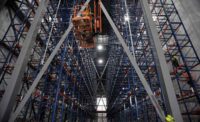The Top 400 Contractors: Focusing on Processes
Competition remains strong in most sectors, although some contractors are beginning to see an increase in their market backlogs. "Owners are still very price-conscious but are also driven by getting the right match of talent for their projects," says Robin Savage, COO of Robins & Morton.
The gradual buildup of backlog has given many large contractors the freedom to pick and choose. For example, Messer Construction has opted for a more controlled and consistent growth rate, says Tim Steigerwald, senior vice president. "Despite the increased volume of work in the marketplace, we have made the decision to only pursue a certain volume of it in order to support our company's long-term growth plan."
Ferrovial Agroman US is another firm that is being selective, according to Daniel J. Filer, vice president of business development. In Ferrovial's markets, competition on hard-bid transportation projects has been fierce, he notes. But now design-build and even public-private-partnership projects also are becoming competitive. "Our strategy for success is to continue to pursue projects where we bring value to the project and not chase everything that moves," he says.
Lean, Mean Contracting Machine
Although many contractors say margins are slowly creeping up, concerns about a lack of staffing and the expected resulting rise in labor costs have contractors wary. So, more firms are seeking ways of improving productivity through process improvements. Many firms are beginning to embrace lean process techniques as a way to squeeze out waste.
"We are implementing lean techniques throughout the company," says Pat Di Filippo, executive vice president of Turner Construction. He says the firm is analyzing numerous methods for eliminating waste. For example, Turner is using modular subassemblies so that everything above the ceiling is manufactured in outside shops, shipped to the site and installed as the component is needed.
Careful scheduling of material and supply deliveries is another lean technique. "We track schedules carefully on tablets and bring the assemblies in only when it is ready to install. That way, nothing touches the floor," Di Filippo says.
SpawGlass is another proponent of lean construction, according to Joel Stone, CEO. "We have driven lean into all aspects of our business, and we are beginning to see the product of our investment." Stone estimates that, through the use of lean on one of its projects, SpawGlass was able to achieve a work-in-place volume per day of half a million dollars.
Prefabrication increasingly is becoming a critical tool in lean construction practice. Measuring project performance in the field using various scanning technologies, as well as lean processes and prefabrication, contribute to "enhancing our understanding of field production and continuing to wring waste out of the process of construction," says Brad Dimeo, CEO, Dimeo Construction Co.
An example of prefabrication is Messer Construction's $189-million Joint & Spine Center project at the Christ Hospital Health Network, Cincinnati, which is using prefabricated restroom units and mechanical racks. "The use of prefabricated restroom units, for example, eliminates the need for multiple trades in a small restroom area down the stretch of the project, meaning a safer work environment and fewer scheduling issues," says Steigerwald.
Fueling Uncertainty
The drop in fuel prices has both caused pain and opened up prospects for contractors. Firms in the oil-and-gas sector have experienced delays on many projects as oil producers try to gauge where the market for oil is going. But contractors in other markets are monitoring fuel prices to see if their firms will be affected.






